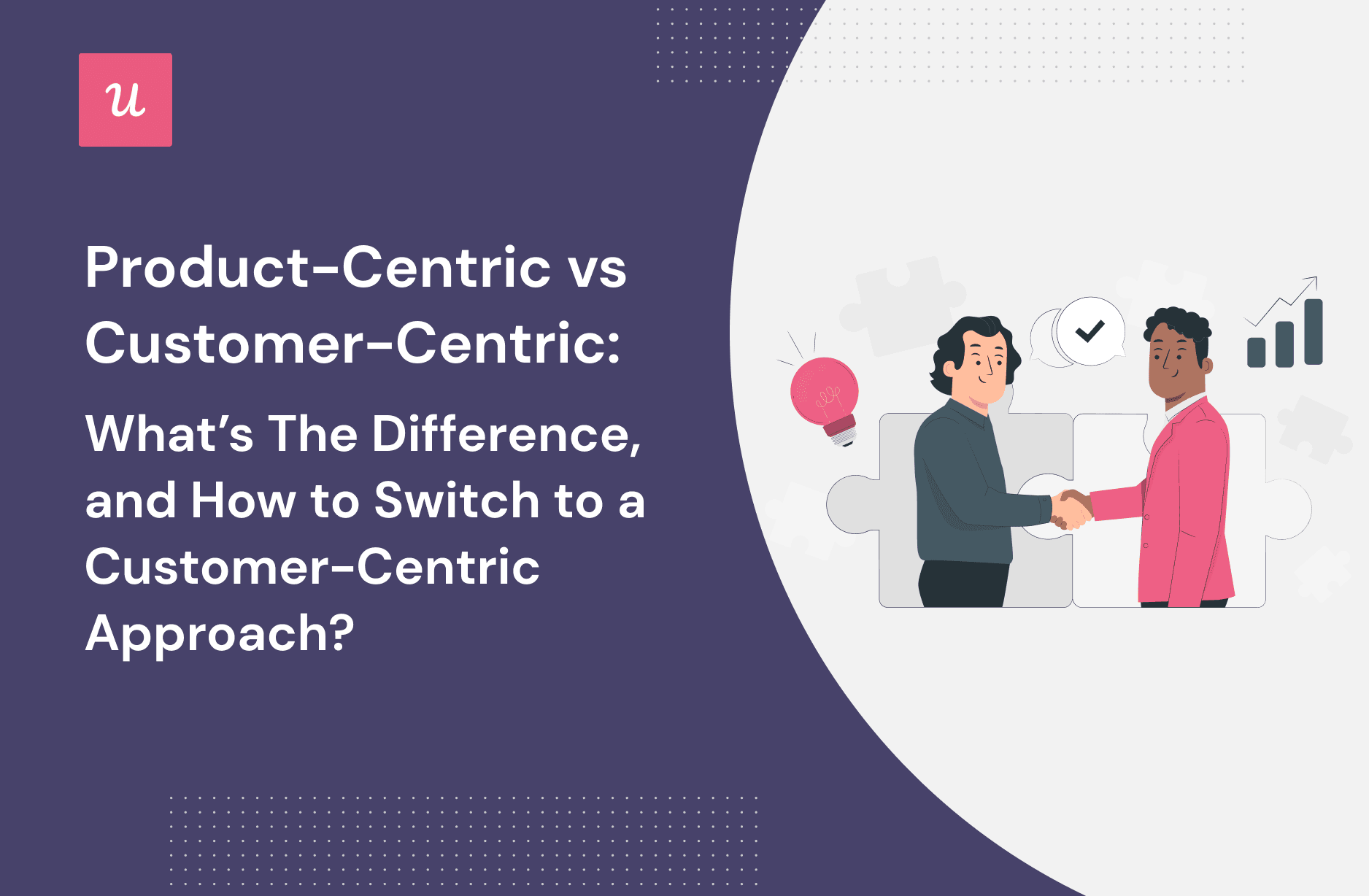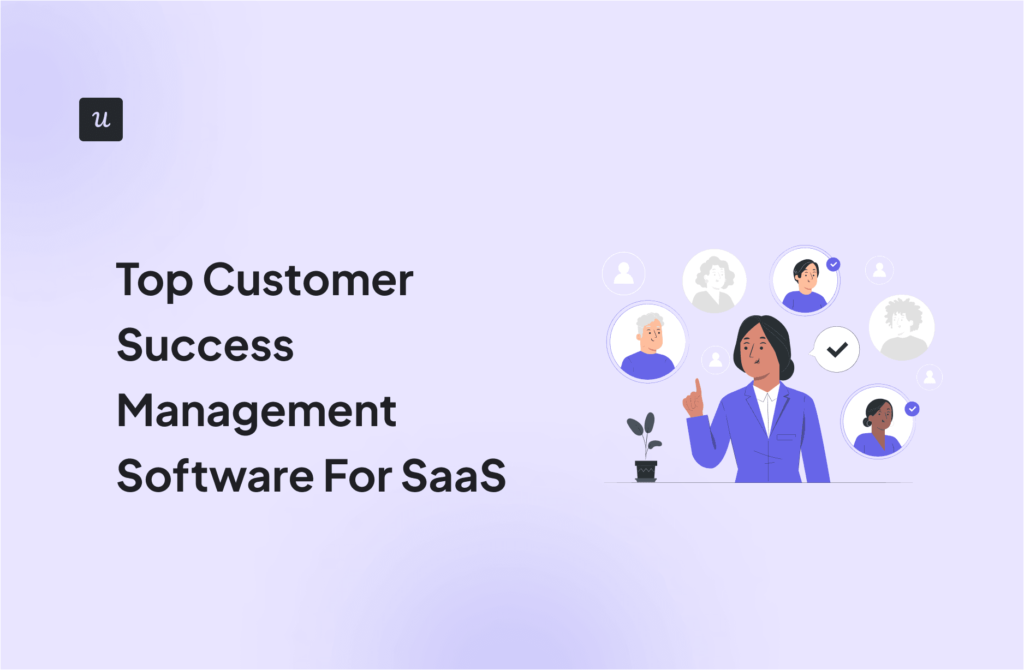
Product-Centric vs Customer-Centric: What’s the Difference, and How To Switch to a Customer-Centric Approach?
Product-centric vs customer-centric: which approach do you use for your SaaS business?
By understanding the difference between a product-centric and a customer-centric approach, you can create a strategy that’s aligned with your SaaS growth goals.
In this article, we will examine product-centric vs customer-centric approaches and discover how to switch your SaaS business to a customer-centric approach.
Try Userpilot Now
See Why 1,000+ Teams Choose Userpilot

Product-centric vs customer-centric – quick summary
- A product-centric company focuses its attention on the product regardless of the customers and demand in the market.
- A customer-centric company puts the customers at the core of every strategy and focuses on creating solutions that satisfy its users’ needs.
- Customer-centric companies analyze customers’ needs and pain points, while product-centric companies aim to create and sell the best new products.
- The customer-centric strategy focuses on customer success and building long-term relationships. On the other hand, the product-centric approach relies on the product’s core features and functionality to sell.
- The main goal of product-centric companies is to create the best product quality, regardless of the customer experience. The primary purpose of customer-centric companies is to create the best customer experience.
- Being product-centric means your SaaS company gets to focus on building the best products and features, creating a powerful brand positioning, and improving customer loyalty.
- Customer centricity allows you to create better relationships with customers, prioritize customer needs, and increase customer retention.
- Here are a few tips on how to shift from a product-centric to a customer-centric approach:
- Have a public roadmap that welcomes feedback.
- Have a pricing strategy that encourages users to engage with your product.
- Collect continuous feedback with multiple types of surveys.
- Launch with a beta tester for PMF instead of a big launch.
- Enhance user experience with product-led onboarding.
- Userpilot helps you build a better onboarding process with a range of engaging UI patterns (like modals, slideouts, and checklists) and offers inclusive and ongoing support with a Resource Center.
What is a product-centric approach in SaaS?
The product-centric approach focuses on the product regardless of the customers and demand in the market. SaaS companies who use this approach are always adding new features and updating old ones.
What is a customer-centric approach in SaaS?
The customer-centric approach puts the customers at the core of every strategy and decision. A SaaS company that takes this approach focuses on customer research and uses the data gathered from the research to build products/features that users want.
Product-centric vs customer-centric: What’s the difference?
The main difference between the product-centric and customer-centric models is the approach to the customer. While product-centric companies rely on creating and selling the best new products, customer-centric companies aim to analyze the customers’ needs by collecting valuable customer insights and feedback to create the best solutions for them.
There is also a difference in strategy between these two approaches. A product-centric company will rely on the product’s core features and functionality to sell. Success is measured by how well the product sells.
A customer-centric company will focus more on keeping their customers satisfied and building more long-term relationships with their customers. They measure the company’s success based on customer loyalty and their renewal, upsell, and referral rates.
The differences between the product-centric and customer-centric approaches are not limited to customers and strategy. Which approach you prefer depends on your strategic goals.
The main goal of product-centric companies is to create the best product quality, regardless of the customer experience. On the other hand, the primary goal of customer-centric companies is to create the best customer experience and meet customer demands.

What are the benefits of the product-centric approach?
Let’s take a look at some of the benefits that the product-centric approach can offer.
Focus on building the best features
Being product-centric means your SaaS company gets to focus on one thing – building the best products and features. This means you get to maintain a singular focus on creating and improving products that work, saving you and your team time and effort.
Create a powerful brand positioning
Another advantage of the product-centric approach is that it can create powerful brand positioning because of your product quality. Everyone remembers the feeling of a great product, no matter how small the product was.
Improve customer loyalty
If you focus on creating great products, your customers will see that and never leave your brand. A perfect case study would be Apple. Apple has been blowing people’s minds since the 1980s, and we’re still obsessed.
With every new product release, customers are always eager to get their hands on it. The products they create satisfy people in ways they didn’t even know they wanted, but they can’t imagine not having them.
What are the weak sides of the product-centric approach?
Here are some of the disadvantages of product-centricity:
- The product-centric approach allows you to disregard your customers’ needs and challenges.
- Lack of customer research can mean underestimating or overestimating the need for a product.
- You fail to define your product-market fit, leading to your business failing.
- Your competitors can easily imitate your products and sabotage your efforts.
- You have to spend lots of time and effort educating and convincing prospective customers and early adopters in the market to give your product a try.
What are the benefits of the customer-centric approach?
Customer centricity places customer success above everything else, including product innovation. The customer-centric model allows SaaS companies to get in touch with their customer base and update products as needed. Here are some of the benefits of the customer-centric approach:
Create better relationships with customers
Customer-centricity directly affects your customer relationships positively. By putting your customers first and creating an atmosphere where your customers can talk about their issues and concerns, you will make a good relationship with them, which will lead to a lower churn rate, increased customer lifetime value, and retention rate.
Prioritize customer needs and challenges
Another benefit of being a customer-centric company is understanding your customers’ challenges and creating solutions to tackle that challenges. When customers see that you prioritize them no matter what, they will become more loyal and will increase your reputation with a word of mouth.
Increase customer retention
Spend more time understanding the entire customer journey, and pay more attention to their pain points, and you will have happier customers. As they say, “happy customers always come back”.
What are the weak sides of the customer-centric approach?
Here are some of the weak sides of the customer-centric business approach:
- There are so many customer-centric businesses, and this means only one thing – increased competition.
- Due to more focus on the customers, your product quality might suffer, which is bad for your business.
- The customer-centric approach requires extensive preparation and market research, which is cost and time-intensive.
- Although customer-centricity creates more flexibility within your company, your business structure is more prone to problems.
- Unlike the product-centric approach, it takes much longer to build a solid brand reputation and position with the customer-centric approach.
Why should you choose the customer-centric approach?
Though both product-centric and customer-centric approaches have their own advantages and disadvantages, customer-centric is definitely more preferable and profitable in the long run.
You are making your product for your customers. If they are not satisfied with your product or feel that their concerns are not taken into consideration, then you are at risk of losing them. Regardless of how great your SaaS product is from your perspective, customer satisfaction is the key to success.
How to shift from a product-centric to a customer-centric approach?
as discussed above, the product-centric model might not always be the best approach for your business. SaaS businesses require excellent customer experience, constant change, and brand awareness, so you are better off leveraging the customer-centric approach.
Here are a few tips on how to shift from product centricity to customer centricity:
Have a public roadmap that welcomes feedback
A public product roadmap is an easily accessible web page where both potential and existing customers, team members, or investors can view your roadmap and give constructive feedback. Having a public product roadmap ensures that you put your customers first and allows you to:
- Get customer feedback
- Share what you and your team are working on
- Nurture customers waiting for a particular feature launch
- Capture prospects looking for a specific feature.

Have a pricing strategy that encourages users to engage with the product
Freemium and free trials are examples of product-led growth, which is popular among customer-centric SaaS companies.
With the freemium pricing strategy, companies offer basic products for free and an advanced version with more features and services for a fee. The free-trial model lets customers explore a product without paying for a limited time.
Using either of these models will allow you to receive many signups, which will help you gain more insights into how customers engage with your products/features.

Collect continuous feedback with multiple types of surveys
How can you know your customer’s needs and problems without hearing directly from them?
Are your customers happy with your solution? How do you measure customer happiness?
The answer is through SURVEYS.
You should use microsurveys across different stages of the user journey to understand how users feel about your product.
You can also use CSAT, NPS, customer effort score, and customer happiness surveys to ask for user feedback and act on the data you get.

Launch with a beta tester for PMF instead of a big launch
Instead of creating a product and immediately launching it into the market without knowing if it’ll be well-received, you can launch a beta tester for product-market fit. This way, you can get users to use your product, collect feedback and make adjustments if needed.
In case you are just starting out and do not know how or where to get beta testers, you can leverage free platforms. Betalist, Betabound, and Startup Lift are three platforms that you can use to beta test your SaaS startup.

Enhance user experience with product-led onboarding
Product-led onboarding introduces customers to features according to their needs and stages in the customer journey. This means you only show users features that you know will resonate with them.
With product-led onboarding, you will keep your customers engaged as they are interested in the functions and features of your product.
Userpilot helps you build a better onboarding process with a range of engaging UI patterns (like modals, slideouts, and checklists) and offers inclusive and ongoing support with a Resource Center.
You can use a variety of its features to create interactive walkthroughs, onboarding checklists, and tooltips to guide customers and drive them to the activation point. What’s more interesting is that you can create all of this code-free. This means you can set up and launch your in-app experiences in just a couple of minutes without having programming skills.

Conclusion
Now you know the key differences between customer centricity and product centricity.
To decide whether product-centric or customer-centric is a better approach, you need to understand your business offering well.
Choosing product-centric is your best bet if you are building a product for which no market need has been identified. Going customer-centric makes more sense when there’s already a demand in the market.
However, switching to a customer-centric approach would allow you to build your business with steady growth and gain a competitive advantage in the long run.
If you want to better understand how your users behave inside the app, collect feedback contextually, and reach out to your customers to improve engagement and boost customer success, get a Userpilot Demo and get started.







